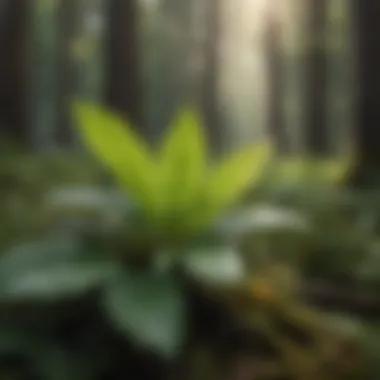Endangered Plants of New York: An In-Depth Analysis


Intro
The vibrant landscapes of New York are home to a diverse range of plant species, many of which face the looming threat of extinction. The intricate tapestry of these plants is not only essential for maintaining ecological balance but also crucial for the state's rich biodiversity. Understanding the plight of endangered plant species provides a lens through which to view the broader issues of habitat loss, climate change, and the effectiveness of conservation strategies.
Diving into the realm of New York's endangered flora reveals the interconnectedness of various ecosystems. Each plant species has a unique role, from stabilizing soil to providing habitat for wildlife. Recognizing their significance prompts a deeper conversation about ecological stewardship and the need for community involvement in preservation efforts. Through a thorough examination, we will cover the species at risk, the threats they face, and the ongoing initiatives aimed at saving them. \span style='color: red;'>Let's embark on this journey to better understand the challenges and triumphs in safeguarding these invaluable natural resources.span>
Understanding Woodland Ecosystems
In exploring endangered plants, one cannot ignore the significance of woodland ecosystems. These forests are not merely collections of trees but vital habitats facilitating numerous ecological processes. The complexities of woodland ecosystems rest heavily on their biodiversity.
Importance of Biodiversity in Forests
Biodiversity in forests guarantees a resilient ecosystem. A diverse array of plant species supports a multitude of animal life and maintains stable soil conditions, which are imperative for preventing erosion. Here are some key roles biodiversity plays in forests:
- Nutrient cycling: Multiple plant species contribute to the cycling of nutrients, enriching the soil and supporting growth.
- Pollinator support: Diverse floral forms attract various pollinators, ensuring that plants reproduce successfully.
- Disease resistance: A variety of species can buffer against disease outbreaks, promoting overall forest health.
The loss of plant variety can lead to a domino effect, causing negative repercussions throughout the food chain.
Role of Forests in Climate Regulation
Forests are nature's air conditioners, absorbing carbon dioxide and releasing oxygen, thus playing a crucial role in climate regulation. Specific species adapt to varying temperatures and shifting weather patterns, making them barometers of environmental change. The interconnected nature of forests also aids in:
- Water retention: Tree roots hold soil, reducing runoff and facilitating groundwater recharge.
- Microclimate creation: Dense canopies moderate temperatures underfoot, providing shelter for diverse organisms.
**"Healthy forests are not only a storehouse of carbon but also a fortress against climate change."
Sustainable Forestry Practices
To ensure the survival of both the flora and fauna, sustainable forestry practices are paramount. These methods aim not only to exploit resources but also conserve them for future generations.
Principles of Sustainable Forestry
Sustainability hinges on several principles that guide forest management. Some of these include:
- Selective logging: Rather than clear-cutting, this method focuses on harvesting specific trees, allowing the ecosystem to recover faster.
- Reforestation: Planting new trees to replace those removed sustains habitat and biodiversity.
- Reduced chemical use: Minimizing the application of pesticides and herbicides protects non-target species.
Case Studies of Successful Implementations
Around New York, successful implementations of sustainable forestry can be seen. The Adirondack Park serves as an exemplary model.
- Adirondack Park Agency (APA): Through careful regulation, the APA has facilitated forest conservation while also allowing for recreational use. Forest management plans prioritize biodiversity and the protection of endangered species.
Woodland Stewardship Techniques
Implementing effective stewardship techniques is instrumental in maintaining the health of woodland ecosystems. This focused approach can make a significant difference in the fight against plant extinction.
Forest Management Plans
A solid forest management plan outlines actions to nurture and protect vital forest resources. These plans often include:
- Monitoring species health: Regular assessments can identify declining populations early.
- Habitat restoration: Enhancing native plant communities to outcompete invasive species can stabilize ecosystems.
Conservation Strategies
Conservation strategies are the backbone of preserving endangered plants. Local initiatives often lean heavily on community involvement. Engaging citizens through:
- Education programs: Informing the public about local plant life encourages stewardship efforts.
- Volunteer initiatives: Community-led replanting and cleanup days can foster a sense of ownership and responsibility for local ecosystems.
Prologue to Endangered Plants
The subject of endangered plants weaves into the fabric of our ecological narrative. Understanding the plight of these species is crucial, as they serve more than just aesthetic purposes; they play integral roles within their ecosystems. Each plant, from the smallest wildflower to the towering tree, contributes to a web of interactions that sustain life.
In New York, a state renowned for its diverse landscapes, the existence of endangered plants reveals the underlying health of the environment. These plants can often be seen as canaries in the coal mine, indicating the well-being of the larger ecological system. A decline in their numbers could signal broader issues affecting water quality, soil health, and habitat availability.
Key components to consider about endangered plants include:
- Biodiversity Importance: The disappearance of a single species can disrupt food chains and affect other flora and fauna.
- Cultural Value: Many plants hold historical and cultural significance, influencing local traditions, cuisines, and medicine.
- Ecological Benefits: Endangered plants may offer unique adaptations or traits valuable for climate resilience and restoration efforts.
The loss of plant diversity not only threatens ecosystems but can also jeopardize human livelihoods. For forestry professionals and academics, it is essential to investigate the various threats these species face, including habitat destruction and climate change. By putting the spotlight on endangered plants, we can galvanize efforts towards both conservation and sustainable management strategies.
Endangered plants signal the health of an ecosystem, guiding conservation efforts and influencing biodiversity policy.
In summary, the introduction to the matter of endangered plants sets the stage for an enlightening exploration of species at risk, their roles within the environment, and the significance of preserving biodiversity. This article aims to inform and inspire action aimed at safeguarding these vital components of our natural world.
Overview of Plant Endangerment
Plant endangerment is a pressing issue that resonates more deeply than simple statistics alone. In a world where biodiversity is unmatched, the decline of plant species is often an early warning bell for ecological imbalance. Loss of a single plant species can ripple through entire ecosystems, impacting not just flora but also fauna, soil health, and water cycles. Understanding plant endangerment situates us at the heart of conservation efforts.
Importance of Plant Species
Plants are the very foundation of life. They provide oxygen, food, and habitat—not to mention their roles in water purification and soil stabilization. The interconnectedness of species means that protecting the most vulnerable among them isn't just about preserving a single entity; it's about safeguarding the web of life. When we talk about the significance of plant endangerment, we need to acknowledge that it isn't just an environmental issue. It touches on culture, economy, and health as well.
For instance, local communities that rely on certain plants for traditional medicine are put at risk when those plants decline. When such plants vanish, so can cultural practices and knowledge associated with them.
Driving Factors Behind Plant Endangerment
Several factors contribute to the decline in plant species. Some of the most pressing include:
- Habitat loss: Urbanization, agricultural expansion, and infrastructure development lead to direct destruction of habitats. Natural settings where many of these plants thrive are drastically reduced, squeezing them out of existence.
- Climate change: Shifting weather patterns and increasing temperatures can disrupt the delicate balance of ecosystems. As conditions change, some plants may not adapt quickly enough to survive.
- Invasive species: Non-native plants can outcompete local flora for resources, further stressing endangered species and making recovery even more daunting.
Why It Matters
The examination of plant endangerment is not just academic. It reveals a lot about how societies prioritize and manage natural resources. By recognizing these trends and threats, strategies can be formed to combat them effectively. Information is power, and understanding the intricacies of plant endangerment gives conservationists and the public the tools they need to make informed decisions.
In the broader narrative of environmental conservation, awareness of plant endangerment emerges as an essential theme. The fragility of plants signifies more than mere ecological loss; it is a poignant reminder of our shared responsibility to preserve biodiversity. As stewards of the Earth, it is not just about preserving what we have but ensuring that future generations inherit a thriving natural world.
"Plant endangerment highlights the fragility of ecological systems; as we lose plants, we lose the integral parts of our natural legacy."
Significance of Biodiversity
Biodiversity is often called the engine driving the mechanisms of ecosystems. In New York, this is no different. The variety of plant species enriches not only the natural environment but also human life. Biodiversity serves as a cornerstone of ecological processes that sustain life on Earth. It encompasses the variability of life forms, the ecosystems they inhabit, and the genetics they possess. Its significance in the context of endangered plants cannot be overstated.
Ecological Balance and Stability
Plants contribute essential functions in ecosystems. By producing oxygen and providing food, they form the basis of food chains. A species-rich environment allows for a balance between predator and prey, fostering stability within the ecosystem. When plants are endangered, this balance is disrupted. Declines in plant populations can ripple through the food web, affecting herbivores, predators, and ultimately, human communities.


Moreover, diverse plant life plays a role in soil health, water retention, and nutrient recycling. Healthy ecosystems buffer against environmental changes. By preserving biodiversity, we not only maintain ecological balance but also enhance resilience against threats such as climate change.
Economic Benefits
The benefits of biodiversity extend to economic realms as well. Many medicines and agricultural products are derived from plant species. The genetic diversity found in plants can lead to new crop varieties that are more resistant to diseases or can better withstand changing climates. This is particularly significant for farmers in New York, who rely on various plant species for their livelihoods.
In addition, properly managed ecosystems provide tourism opportunities, benefiting local economies. Parks and natural areas attract visitors interested in hiking, birdwatching, or simply enjoying nature. Thus, believing that the protection of endangered plants has economic implications is not far-fetched; their conservation can lead to increased opportunities for sustainable agriculture and tourism.
Cultural Significance
Plants are integral to cultural identity. Many communities in New York hold traditional knowledge about local flora, using certain species for food, crafts, and spiritual practices. When biodiversity is under threat, these cultural practices can diminish. Protecting endangered plants preserves not just the species themselves, but the cultural heritage connected to those plants.
"When the last tree is cut, the last fish is caught, and the last river poisoned, we will realize that we cannot eat money" – Native American proverb.
This adage emphasizes that the ecological well-being is tied to human existence. The loss of biodiversity is more than just an environmental issue; it is a cultural crisis as well.
Contributions to Scientific Knowledge
Biodiversity offers valuable insights into ecological interactions, evolutionary processes, and environmental health. Research concerning endangered plant species can illuminate broader ecological principles. Understanding how these plants survive and adapt contributes to our knowledge base, which can be applied to conservation strategies in other regions. The preservation of diverse plant species is, therefore, not just a local concern, but a global imperative that supports scientific advancement.
Final Thoughts
The significance of biodiversity stretches beyond sheer numbers of species. It encompasses the underlying relationships that allow ecosystems to function and thrive. For New York's endangered plants, their preservation is crucial for maintaining ecological integrity, economic sustainability, cultural heritage, and scientific progress. Protecting our biodiversity is not just about safeguarding plants—it’s about ensuring the health of our environment and the survival of future generations.
Endangered Plant Species in New York
Endangered plant species in New York do not merely represent numbers on a conservation checklist; they embody the very essence of the region's ecological identity. Their decline ripples through the ecosystem, impacting everything from soil quality to animal habitats. When we examine what's at stake, it becomes clear that protecting these plants is more than just a noble cause—it’s a necessity for the stability and richness of New York's diverse landscape.
A significant aspect of these endangered species is their role in maintaining habitat integrity. For instance, when certain plants disappear, they can take with them vital resources for local fauna, including food and shelter. This phenomenon creates a domino effect, threatening the broader biological community. The loss of a single species can echo through ecosystems, causing ripple effects that might only be felt years later.
Furthermore, these plants contribute to the genetic diversity that sustains ecosystems. Each species plays a unique role in its environment, often interlinked with others through various biological processes. From providing food for pollinators to stabilizing soil, the contributions of endangered plant species cannot be understated.
In New York, biodiversity isn't just a statistic; it’s a complex interplay of life forms that we must understand and foster. Turning our attention towards these endangered species ensures that we take responsibility, not only for the plants themselves but for the ecosystem they support.
Common Bluebell (Campanula rotundifolia)
The Common Bluebell, scientifically known as Campanula rotundifolia, is more than just a pretty flower. This plant is a perennial that typically graces open woodlands and grassy areas with its stunning bell-shaped blooms. However, its existence is threatened by habitat loss and competition with invasive species. The Bluebell is a noteworthy indicator of healthy ecosystems; where they thrive, biodiversity tends to flourish.
Here are some key aspects to consider regarding the Common Bluebell:
- Habitat Preference: Preferring well-drained soils, these bluebells often settle in areas that boast some level of disturbance, enabling adequate sunlight to reach their leaves.
- Role in Pollination: The blooms are crucial for various pollinators, including bees. The availability of Bluebells can offer a consistent food source during critical growth periods for these insects.
This species serves not just as a visual landmark but also as a signifier of environmental health. Protecting the Bluebell means bolstering broader ecological resilience.
Eastern Prairie Fringed Orchid (Platanthera leucophaea)
The Eastern Prairie Fringed Orchid, or Platanthera leucophaea, is a remarkable specimen threatened by urbanization and agricultural expansion. Characterized by its unique fringed petals, this orchid signifies the health of tallgrass prairie ecosystems, which are diminishing rapidly. The Eastern Prairie Fringed Orchid isn't merely a beauty; it's a linchpin of its environment.
Key points about this orchid include:
- Specific Pollinator Requirements: This orchid relies on a specific moth, the Hesparia (a type of sphinx moth), for pollination. Such specialized relationships highlight the intricate webs of dependency in ecosystems.
- Environmental Indicator: A decline in this species often mirrors the degradation of prairie habitats, making it vital to conservation efforts.
Conserving the Eastern Prairie Fringed Orchid indirectly protects a wealth of other species sharing its habitat. These interactions go beyond the floral charms this orchid presents; they extend into the very fabric of the ecosystem’s stability.
Virginia Clethra (Clethra alnifolia)
The Virginia Clethra, also known as Clethra alnifolia, is another plant that holds a cherished place within New York's ecosystem. This medium-sized shrub often grows in wetlands and along waterways, providing both shelter and food for wildlife. Its value stretches further, as it aids in maintaining soil and water quality in these delicate environments.
Important features of the Virginia Clethra include:
- Fragrance and Bloom Time: The aromatic white flowers bloom in summer, attracting pollinators and adding sensory beauty to its surroundings.
- Wetland Vitality: As a native plant, it plays a role in stabilizing wetland areas, offering resistance to erosion and providing critical habitat for amphibians and birds.
Ecological Roles of Endangered Plants
Endangered plants are not just pretty faces in the ecosystem; they play critical roles that impact the broader environment. Understanding these roles emphasizes the importance of conservation efforts. Not only do endangered plants contribute to the biological diversity of their respective habitats, but they also support other species and ecosystem functions.
Biodiversity Boosters
One major benefit of endangered plants is their contribution to biodiversity. Biodiversity itself is fundamental; it enhances ecosystem productivity and stability. Here’s how endangered plants fit into this puzzle:
- Niche Fulfilling: Each plant species occupies a specific niche, which can involve unique interactions with insects, birds, and other wildlife. For instance, the Eastern Prairie Fringed Orchid (Platanthera leucophaea) is a vital player in its habitat, providing nectar for specific pollinators that depend solely on it.
- Genetic Reservoirs: Endangered plants hold genetic materials that can be indispensable for breeding programs aimed at restoring species and maintaining genetic diversity. Such genetic diversity can contribute to resilience against pests and diseases.
Soil Stabilizers
Plant roots do more than anchor the plant; they help maintain soil health and stability. This is especially crucial in areas prone to erosion:
- Erosion Control: Plants like the Common Bluebell (Campanula rotundifolia) have shallow root systems that spread out, helping to bind the soil and prevent erosion. In regions where heavy rainfall can wash away valuable soil, such plants are invaluable.
- Nutrient Cycling: Endangered plants contribute to nutrient cycling by decomposing and returning vital nutrients back into the soil. This process ensures the health and fertility of the land, supporting both flora and fauna.
Climate Regulation
The role of plants in climate regulation cannot be understated. They help moderate temperatures and maintain humidity:
- Carbon Sequestration: Endangered plants absorb carbon dioxide, playing a small but critical role in offsetting climate change. As they grow, they store carbon in their biomass, which acts to lower atmospheric carbon levels over time.
- Microclimate Creation: Some endangered plants create unique microclimates that can benefit other species. For example, dense shrubbery can provide cooler areas and shelter for various small animals, especially in urbanized settings.
"The loss of a single plant species can ripple throughout an ecosystem, affecting not just wildlife but also the balance of entire landscapes."
Pollinator Support
Endangered plants are often crucial for specific pollinators, which in turn contribute to the reproductive success of many other plants:
- Habitat for Pollinators: They provide food sources and habitat for bees, butterflies, and other critical pollinators, enabling these species to thrive. This is particularly true for the Virginia Clethra (Clethra alnifolia), which attracts numerous pollinating insects with its fragrant flowers.
- Species Interdependence: The absence of certain plants can lead to declines in pollinator populations, which can have cascading effects on plant reproduction and biodiversity.
The End: The Bigger Picture
The ecological roles of endangered plants are integral to maintaining the health and vitality of ecosystems in New York and beyond. Their contributions extend far beyond what meets the eye, supporting functions that many other species, including humans, rely on. Recognizing their significance underlines the pressing need for conservation initiatives. By advocating for these plants, we help secure a more balanced ecosystem and a healthier planet for future generations.
Threats to Plant Life
The survival of plant species in New York is hanging by a thread, and understanding the threats to their existence is paramount for effective conservation efforts. This section delves into some of the primary threats, shedding light on the intricate networks that endanger plant life. Each challenge not only hampers the resilience of ecosystems but also undermines the balance of biodiversity, ultimately impacting the entire food chain.
Habitat Destruction
Habitat destruction is one of the most significant threats to plants, particularly in a densely populated state like New York. Urban expansion, agriculture, and infrastructure development are notoriously voracious in consuming green spaces. When natural habitats are converted into residential or commercial zones, plants lose their homes, leading to drastic declines in their populations.
Consider the story of wetlands in New York. These ecosystems are essential for countless plant species. When wetlands are drained or filled to accommodate housing developments or factories, plants like the Eastern Prairie Fringed Orchid vanish from their once-vibrant habitats.
The fallout from habitat destruction is profound. It causes fragmentation, isolating small populations of plants, which makes them more susceptible to other threats such as pests and disease. Protecting existing habitats and restoring degraded ones must be a top priority for conservation leaders and communities alike.


Invasive Species
Invasive species are like uninvited guests that take over the party, outcompeting native plants for resources. These non-native organisms can alter ecosystems in unpredictable ways. For example, Japanese knotweed has made a name for itself as a notorious invader in New York. It spreads rapidly, choking out local flora, and ultimately reducing plant diversity.
The competition for sunlight and nutrients that invasive species create can suffocate the growth of endangered plants, effectively tipping the scales of survival. Invasive species often thrive in disturbed habitats, which is why their presence is particularly felt in areas already stressed by human activity. Public education on recognizing these weeds, along with stewardship activities aimed at weeding them out, is crucial in turning the tide against these unrelenting intruders.
Climate Change
Climate change injects another layer of danger into the already tender situation. Changes in temperature and precipitation patterns can make certain habitats inhospitable for native plants.
A local example would be the shifting ranges of species like the Common Bluebell, which is slowly losing its ground as warming temperatures and altered rainfall patterns change its natural growing conditions. As climate zones shift, many plants may find themselves in a climate different from that to which they are adapted, causing declines or potential extinction.
Moreover, climate change exacerbates other existing threats. For instance, during extreme weather events, invasive species may flourish in disturbed areas, further pushing endangered plants out of the race. It's not just about the immediate impacts of a changing climate; it's about how these changes reverberate through ecosystems, affecting all forms of life.
"The health of ecosystems is fundamentally interconnected with the threads of climate, habitat, and the delicate balance between species. Understanding these interrelationships is critical for robust conservation strategies."
In summary, the threats to plant life in New York are multifaceted and interrelated. Addressing these challenges requires sound science, targeted policies, and community action. By comprehensively identifying and tackling these threats, we take a step toward preserving New York's intricate plant life.
Legal Framework for Conservation
Exploring the legal landscape surrounding the conservation of endangered plants in New York reveals the crucial role regulations play in safeguarding the region's unique flora. The legal framework for conservation not only provides essential guidelines and protocols for environmental protection but also serves as a vital support system for state and federal initiatives aimed at preserving endangered species. Understanding these laws can help bolster efforts to ensure that these plants not only survive but thrive in their natural habitats.
There are several key elements to consider in the realm of conservation legislation:
- Protection of Habitat: Laws that protect the environments where endangered plants grow are critical. Preserving natural habitats limits the encroaching threats to these ecosystems.
- Regulatory Compliance: These regulations require adherence from developers, landowners, and other stakeholders, helping to minimize harmful activities that could jeopardize plant species.
- Funding Opportunities: Many conservation laws provide funding for restoration projects, research, and public education.
- Public Engagement: The framework encourages public participation in conservation efforts, fostering community awareness and involvement.
The legal structure serves as a backbone for maintaining biodiversity in New York, necessitating cooperation across various sectors to implement effective conservation strategies.
State Regulations
The state regulations governing plant conservation, particularly in New York, are a tapestry of guidelines and rules designed to prevent the loss of native plant species. The New York State Environmental Conservation Law (ECL) encompasses critical statutes that specifically address the conservation of endangered and threatened plants. Under this law, certain species are designated as endangered or threatened and are given special protection.
Key components of state regulations include:
- Identification of Protected Species: The New York State Department of Environmental Conservation (DEC) maintains a list of plants that are endangered, threatened, or of special concern. This list is crucial for informing conservation efforts.
- Regulations on Take and Trade: It is illegal to collect, sell, or otherwise harm these plants without necessary permits, thus protecting them from exploitation.
- Land Use Planning: New York regulations require that state agencies incorporate considerations for endangered plants into land use planning. This approach ensures that potential impacts on these species are evaluated before any development decisions are made.
By fostering collaboration between agencies, researchers, and communities, state regulations in New York act as potent tools in protecting the region’s delicate plant ecosystems.
Federal Policies
At the federal level, the Endangered Species Act (ESA) stands as a cornerstone of environmental legislation in the United States. Established to protect both endangered plants and animals, the ESA has far-reaching implications for conservation efforts in New York and beyond.
Highlights of federal policies include:
- Listing of Protected Species: The ESA allows for the formal listing of endangered species at risk across the country—including those in New York—providing legal protections against harm.
- Critical Habitat Designation: Once species are listed, the U.S. Fish and Wildlife Service (USFWS) can designate critical habitats, areas essential for the conservation of these species. This designation provides an additional layer of protection against development and resource extraction.
- Recovery Plans: The ESA requires the development of recovery plans for listed species, outlining actions needed to bring populations to sustainable levels.
- Interagency Cooperation: The law promotes cooperation among federal, state, and tribal agencies, ensuring comprehensive strategies for our endangered flora.
"The Endangered Species Act not only focuses on saving individual species but also emphasizes the ecosystems they inhabit, which can have lasting benefits for biodiversity as a whole."
Engaging with both state and federal frameworks is vital for anyone involved in the conservation of endangered plants. It ensures informed actions, facilitates collaboration, and ultimately fosters a deeper understanding of the responsibilities involved in preserving the native plant life of New York.
Conservation Efforts and Initiatives
Conservation efforts play a pivotal role in safeguarding endangered plant species in New York. The delicately balanced ecosystems that house these plants are under constant threat, making active intervention not merely beneficial but, arguably, necessary. Initiatives range from local grassroots projects to large-scale state-sponsored programs, all aimed at raising awareness and fostering community involvement.
Public Awareness Campaigns
Public awareness campaigns are instrumental in educating the general populace about the significance of endangered plants and the ecological roles they play. Without an informed community, efforts to protect these vital species can often falter.
Many organizations utilize various platforms to spread the word. Social media channels like Facebook and Reddit are increasingly leveraged, creating a dynamic space for discussion and promotion. Campaigns often highlight specific plants, explaining their importance in local ecosystems. For example, the Eastern Prairie Fringed Orchid isn't just any flower; it provides critical habitat for pollinators and contributes to overall biodiversity.
"Raising consciousness about endangered plants is often the first step in conservation. It’s not merely about protecting a species, but ensuring a balanced ecosystem that benefits all forms of life."
Additionally, educational initiatives often tie into festivals or community events, making it easier for people to engage. Workshops and guided nature walks enrich the experience, giving participants hands-on learning opportunities. This creates a more profound connection between individuals and the natural world around them.
Community and Volunteer Programs
Community and volunteer programs form the backbone of many conservation efforts. These initiatives not only mobilize residents but also immerse them in the task of preservation. Local ecosystem restoration project attract volunteers who are eager to get their hands dirty, whether it's planting new vegetation or removing invasive species that threaten to choke out native plants.
Programs often incorporate regular citizen science initiatives, where everyday people collect data on plant health, growth patterns, and habitat conditions. This not only aids scientists in gathering information efficiently but also makes individuals feel like they're contributing to a larger purpose. Successful local groups show how active participation fosters a sense of ownership within communities.
Engagement doesn’t stop at just being informed; aspects such as educational programs in schools can have ripple effects, pulling in younger generations to carry the torch of conservation into future.
Role of Technology in Conservation
The intersection of technology and conservation has garnered increasing attention in recent years, particularly in the realm of endangered plants. The adoption of technological solutions presents unique opportunities to enhance the effectiveness of conservation strategies. Employing various innovations can help monitor, analyze, and restore endangered plant species in New York, facilitating a more coordinated and informed approach to preservation.
Data Collection and Monitoring
Data collection has long been the backbone of conservation efforts. Modern technology allows for more accurate and comprehensive gathering of ecological data. Remote sensing technology, for instance, enables researchers to track land-use changes and assess habitat alteration due to urban expansion or climate fluctuations. Drones equipped with cameras can be utilized to survey inaccessible areas, providing a bird's-eye view of vegetation health. Furthermore, mobile applications are now available for community scientists to log their observations of endangered plant species. These platforms aggregate data from users, creating a rich database that experts can use to track changes over time.
Benefits of such technology include:
- Improved Spatial Analysis: Analyzing patterns that traditional methods might overlook, like minor shifts in habitat.
- Monitoring Trends: Keeping tabs on various metrics such as flowering cycles or population density.
- Community Engagement: Involving the public in data collection efforts fosters a deeper connection to conservation activities.
Biotechnology in Restoration
Biotechnology represents a promising frontier in the restoration of endangered plant species. Techniques such as genetic engineering and tissue culture are being explored to enhance plant resilience against diseases and environmental stressors. For example, scientists have been working on developing disease-resistant strains of certain native plants that are vital in maintaining ecological balance. Moreover, biotechnology can expedite the cultivation of plants for reforestation projects. Tissue culture techniques allow for the rapid production of large numbers of genetically identical plants, ensuring a higher survival rate when they are introduced into the wild. This method not only saves time but also contributes positively toward maintaining genetic diversity among populations.
Some vital considerations include:
- Ethics: The manipulation of plant genetics raises ethical questions that necessitate public dialogue and transparent policies.
- Potential Risks: The introduction of genetically modified organisms into an ecosystem must be approached with caution to avoid unforeseen consequences.
"Integrating technology into conservation efforts can shape a more precise, informed, and community-centered approach necessary for preserving New York's endangered plants."
Case Studies of Successful Restoration
The journey towards biodiversity conservation often hinges on restoring lost ecosystems. Case studies of successful restoration not only provide concrete examples of what can be achieved but also offer valuable insights into the practices and principles that lead to positive outcomes. They show the potential impact of human intervention when paired with expert understanding of ecological systems. Successful restoration projects serve as blueprints for similar initiatives, reinforcing the notion that ecosystems can rebound when given the proper support. Through the experiences gleaned from these case studies, stakeholders can appreciate the intricacies of local flora, the role of community engagement, and the scientific rigor that underpins effective restoration efforts.
Restoration of the Pitch Pine Forest
The Pitch Pine Forest stands as a testament to the resilience of nature when efforts are properly oriented towards ecological reclamation. Located primarily in Long Island, these forests are recognized for their unique biodiversity, including several endangered plant species. The restoration process began with community-driven initiatives, where local enthusiasts and environmental organizations came together to address the encroachment of invasive species like Japanese blackthorn.
Key strategies adopted included:
- Selective removal of these invasives to prevent them from overpowering native plant life.
- Re-planting native species such as the Pitch Pine itself, which had suffered from decades of neglect.
- Employing controlled burns to mimic natural fire cycles that these ecosystems historically depended on for regeneration.


The collaborative approach not only rejuvenated the forest, but also tapped into the local knowledge and passion for conservation. Volunteers and local schools engaged in workshops to learn about the significance of this forest, deepening their connection to the ecosystem. From monitoring wildlife to participating in hands-on restoration activities, community involvement became a driving force in the project.
"The success of the Pitch Pine restoration showcases how collective efforts can lead to tangible improvements in local ecosystems."
Regular assessments indicated a marked increase in both plant species diversity and resilience of the ecosystem overall. It stands out as a significant case in New York's conservation narrative, inspiring other communities to embark on similar pathways of reclamation.
Revival of the Atlantic White Cedar Swamp
The Atlantic White Cedar Swamp, once a vibrant ecosystem along the coast of New York, had been drastically affected by overharvesting and urbanization. Losing its characteristic flora meant that many plant and animal species that depended on this environment were at significant risk. However, a concerted effort to revive this habitat has shown promise.
Restoration initiatives began with an assessment of the hydrology, as these swamps thrive in moist conditions. Actions included:
- Improving water flow to restore the natural hydrologic conditions that these ecosystems depend on.
- Eradicating invasive plant species that hinder the growth of native cedars.
- Introducing seedlings of the Atlantic White Cedar, ensuring a mix of genetic sources to build resilience against diseases.
Engagement with local landowners was paramount in this process. Through educational programs and community outreach, landowners learned about the ecological importance of the swamp and were encouraged to participate in its restoration. Many volunteered to create buffer zones to protect newly planted areas from further disturbances.
As a result, the swamp has been slowly reviving. Monitoring reports document not only the rebound of the Atlantic White Cedar but also an increase in associated fauna that serves to strengthen the intricate web of life within this habitat.
Both restoration of the Pitch Pine Forest and the revival of the Atlantic White Cedar Swamp reflect a powerful message: through commitment and collaboration, ecological restoration is not just a possibility, but a reality. These cases contribute significantly to the understanding of how localized endeavors can substantially impact larger ecological landscapes.
Future Directions for Conservation
Conservation, particularly regarding endangered plants in New York, is not just a flicker of concern; it's a vital component of ecological health and diversity. As we step into a future laden with uncertainties and challenges, it's crucial to reflect on the next avenues for effective conservation practices. This section aims to shed light on emerging strategies, potential benefits, and necessary considerations for fostering plant conservation efforts.
One significant avenue for future conservation is the integration of community-driven initiatives. Engaging local communities in conservation efforts cultivates a sense of ownership and responsibility. For example, neighborhood groups could organize local habitat restoration projects, bringing people outdoors and helping them connect with their environment. When diverse communities come together to protect endangered plants, shared knowledge and resources often lead to innovative solutions.
Moreover, public education plays a central role in conservation. Schools, for instance, can implement programs that teach students about local ecosystems, the importance of biodiversity, and how their actions impact the environment. Understanding local flora not only nurtures appreciation among younger generations but also inspires involvement in conservation activities as they grow into responsible adults.
Adopting Technological Advances
Utilizing technology can also bolster plant conservation efforts. Recent developments in remote sensing and GIS (Geographic Information Systems) can provide valuable data concerning habitats and plant populations. By employing these tools, conservationists can identify areas most at risk, track changes in vegetation, and strategically allocate resources.
Additionally, the role of biotechnology in conservation warrants attention. The use of genetic tools can enhance the resilience of plant species, enabling them to adapt to changing environmental conditions. In time, this approach could lead to successful restorations of endangered plants and ecosystems significantly affected by invasive species or habitat loss.
Considerations for Future Conservation
It's essential to acknowledge that while there are numerous potential pathways, not all approaches may be feasible or effective in every context. Economic constraints can limit funding for extensive conservation projects. Hence, prioritizing initiatives based on urgency, feasibility, and potential impact becomes paramount.
Moreover, ensuring that conservation efforts respect local customs and knowledge is vital. Engaging indigenous populations can provide additional insights into sustainable practices that have been effective for generations.
"When we save one species, we often save countless others, and that’s the essence of biodiversity. It is the connective tissue of our water, air, and soil."
Finally, fostering collaboration among government agencies, non-profits, and research institutions is essential. Resources, expertise, and networks are shared, amplifying the potential for positive impact on endangered plant species.
In summary, as we contemplate the future of plant conservation in New York, it becomes clear that combining community engagement, education, advanced technology, and collaboration can pave the way for a more sustainable approach to preserving our rich botanical heritage. Keeping strategies adaptable and inclusive will ensure that the movement toward conservation doesn't merely survive but thrives.
The Role of Individuals in Preservation
The journey of conservation isn't solely the domain of governments or large organizations; individuals play a vital part in fostering and preserving biodiversity, especially when it comes to endangered plants. In New York, where urbanization and climate challenges loom, every small effort makes a difference. Let's take a closer look at how individual action contributes significantly to conservation.
Engagement in local initiatives is one primary avenue through which individuals can manifest their commitment to preserving endangered plants. When community members come together, they can mobilize effectively, driving grassroots movements aimed at restoring habitats and educating others. By volunteering their time for local clean-ups, tree planting events, and awareness campaigns, individuals not only promote the health of the ecosystems but also nurture a collective sense of responsibility.
Engagement in Local Initiatives
Diving deeper into local initiatives, the effectiveness of community-driven projects can’t be overstated. Local conservation groups often run programs focused on specific endangered plant species native to the area. Whether it’s joining a series of workshops aimed at the protection of the Eastern Prairie Fringed Orchid or participating in efforts to combat invasive species threatening native plants, community involvement fosters a deep-rooted connection with nature.
Some common activities include:
- Participating in Ecological Restoration: Many groups focus on restoring areas that have suffered from habitat loss. Here, individuals can help to reseed or replant native species.
- Conducting Local Surveys: Engaging in citizen science projects can help track changes in plant populations, contributing valuable data to scientists.
- Awareness Campaigns: Whether through social media or organized events, spreading the word about endangered plants can educate a wider audience.
"Individuals may feel small in the grand scheme, but together, they can unleash a tidal wave of change."
Educational Resources and Programs
Educational resources play a crucial role in equipping individuals with the knowledge and tools necessary for effective conservation. Many local organizations provide workshops, courses, and informational materials about endangered plants and their ecosystems.
The benefits of such knowledge can manifest in various ways:
- Informed Decision-Making: Understanding local flora and their needs allows individuals to make choices in landscaping and gardening that promote biodiversity.
- Community Seminars: Hosting or attending talks by experts can inspire community members to take on roles in conservation.
- Partnerships with Schools: Local schools can collaborate with conservationists to create program for students that foster early awareness about biodiversity and climate issues.
An individual’s journey in conservation often begins with a simple search on platforms like Wikipedia or engaging with like-minded individuals on Reddit. These platforms offer an abundance of information and community support for budding conservationists.
Ultimately, the path to preserving endangered plants is a mosaic of individual efforts aligned toward a common goal: to safeguard the rich tapestry of life that our ecosystems represent. With each step taken, no matter how small, individuals can create ripples that lead to substantial changes in the environmental landscape.
Impacts of Urbanization on Plant Species
Urbanization stands as a formidable challenge to plant life, particularly in regions experiencing rapid population growth and infrastructure development, such as New York. The transformation of natural landscapes into urban environments can have dire consequences on local flora, with implications extending beyond mere aesthetic considerations.
One significant impact of urbanization is habitat fragmentation. As towns and cities expand, the once continuous stretches of forests or fields are broken apart. This division isolates plant species, making it harder for them to reproduce and adapt. For instance, the Common Bluebell, known for its vibrant floral displays, may find its pollinators disappearing when the land around it is converted for housing or commercial use.
Another critical aspect involves the introduction of invasive species. Urban areas often witness the unintentional import of non-native plants—some of which can thrive in disturbed environments. These invaders can outcompete and displace native plants, limiting their ability to flourish. The Eastern Prairie Fringed Orchid’s delicate ecosystem, for example, could be jeopardized by tenacious invasive plants that latch onto available resources, depriving natives of sunlight and nutrients.
Furthermore, pollution and altered water cycles associated with urban landscapes exacerbate stress on plants. Pollutants from vehicles and industry can impair photosynthesis directly, while changes in drainage patterns may lead to either flooding or drought conditions, both detrimental to delicate plant species. The Virginia Clethra, typically found in wetland areas, is particularly sensitive to alterations in hydrology that might arise from urban development.
The urban heat island effect, caused by heat-absorbing materials used in construction, leads to warmer temperatures in cities compared to rural areas. Plants that are accustomed to cooler environments may struggle with increased thermal stress. With climate variability being a concern, plants like the Eastern Prairie Fringed Orchid could face challenges even if their habitats remain intact.
"When cities grow, it’s not just bricks and mortar that change; the very fabric of our ecosystem frays, leaving behind patches of what once was."
Lastly, we cannot overlook the psychological impacts of urbanization. Resilience of ecosystems often relies on human relationships with nature. If urban dwellers lose touch with local plant life, particularly endangered species, it diminishes the likelihood of community-driven conservation efforts. Engaging local populations in ecological education is paramount to rekindling that connection.
In summary, urbanization profoundly alters the landscape, bringing about a complex web of challenges for plant species. The interactions between habitat loss, invasive species, pollution, and shifting community attitudes collectively undermine the fragile balance that supports biodiversity. Understanding these dynamics not only informs conservation efforts but also empowers actions that protect New York’s unique plant life from the relentless march of urban development.
The End: A Call to Action
The topic of endangered plants in New York carries significant weight in our current environmental dialogue. Focusing on this issue is not simply an academic exercise; it is crucial for preserving the very fabric of our ecosystems. The plants at risk provide essential services, from air purification to habitat for wildlife, reminding us that we are all interconnected.
This article has illuminated various aspects of plant endangerment, including specific species like the Common Bluebell and Eastern Prairie Fringed Orchid, their ecological roles, and the numerous threats they face. By understanding these complex interactions, individuals and organizations can better appreciate the importance of biodiversity in maintaining ecological balance.
Benefits of Conservation Efforts
Take a moment to consider the benefits that arise from preserving endangered plants:
- Ecosystem Stability: plants are foundational components of their habitats, contributing to soil health and water quality.
- Cultural Significance: Many plant species hold cultural value for local communities, often intertwined with traditional practices and medicinal use.
- Climate Resilience: Healthy plant communities can mitigate the impacts of climate change, acting as buffers against extreme weather.
"Preserving our endangered plants today not only safeguards our environment but enriches our lives tomorrow."
Considerations for Action
So what can be done? The responsibility lies partly on shoulders of every New Yorker. Here are some practical steps to consider:
- Educate Yourself: Knowledge is power. Familiarize yourself with local flora and understand which species are endangered.
- Participate in Local Conservation Programs: Engage with community initiatives that focus on planting native species or removing invasive plants.
- Advocate for Policy Change: Support legislation that prioritizes environmental preservation and habitat restoration. This can often be done by contacting local representatives.
By investing time and resources into the preservation of endangered plants, individuals and communities can emerge as powerful stewards of their environment. Every small action adds up, contributing to a larger movement toward ecological health and sustainability.







